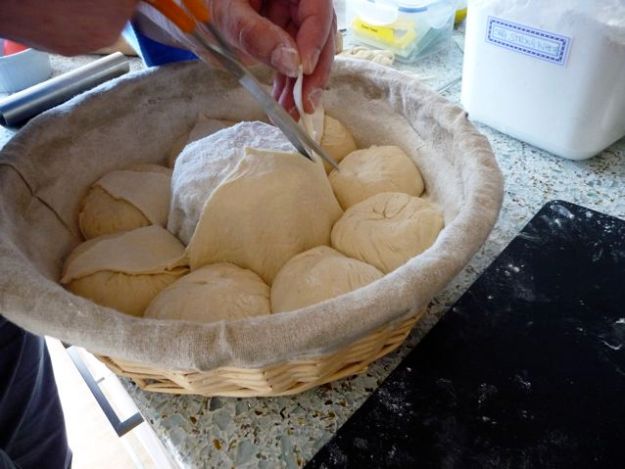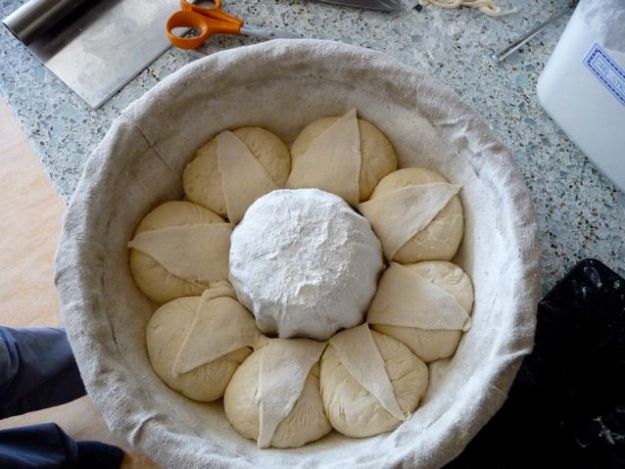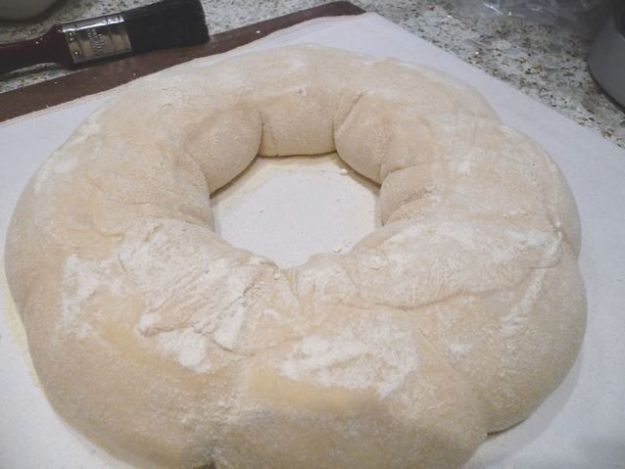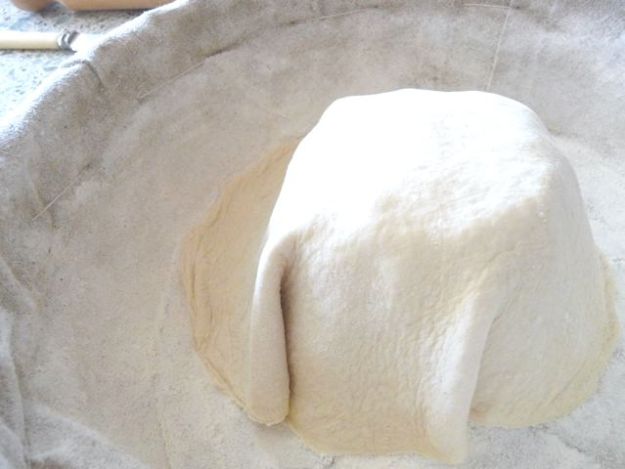 Using this lovely banneton makes it easy to create a Couronne Bordelaise, one of the breads that I made recently here. If you don’t have one of these, you can put a small bowl in a basket and cover it with linen for a similar effect. For a recipe and instructions …
Using this lovely banneton makes it easy to create a Couronne Bordelaise, one of the breads that I made recently here. If you don’t have one of these, you can put a small bowl in a basket and cover it with linen for a similar effect. For a recipe and instructions …
I have tried this now with various doughs, you need something that you are happy shaping into balls, not too firm, not too loose. The Vermont sourdough which is made with a little rye flour works well, or maybe one of the firmer yeasted doughs would do a good job.
The one I made yesterday used a basic white sourdough made with:
150 g white starter (100% hydration)
500 grams white bread flour
320 grams water (this has caused difficulties for one reader, so if you are unused to using a wetter dough, then reduce the amount of water by 50 g to make the dough easier to work with, or use the weekly sourdough formula which gives you a firmer dough)
11 g salt
Mix, do three light kneads over half an hour.
Then leave for a further two and a half hours with stretch and folds, if you remember, every forty minutes or so.
Divide the dough into nine portions; make eight of these the same weight and the ninth a bit heavier. These ones here were approximately 100 grams in weight.
Pre-shape the dough into little balls and leave to rest on a floured surface.
Flour your basket well, do not skimp on the flouring! I got away with white flour this time, but I had used rye on it previously which I prefer to use for flouring cloths.
Take the heaviest boule, flatten it and then roll it out into a circle that will drape over the centre part and extend by at least 2 cms into the base of the basket. As I am incapable of rolling dough thinly into a circle I put a dinner plate over my best effort and cut round it. The photo below is from the first time I made it with the Vermont sourdough recipe.
Do not skip this step! Reshape the eight remaining boules so they are nice and tight. Damp the central circle of dough with a little water but just a touch.
Place the eight balls in the basket gently (Do not press them down), seam side up. If your boules don’t join up at this point, don’t worry, they will once the dough has proved some more.
Then, the slightly tricky part, you need to cut eight triangles of dough from the centre ‘hill’. You start from the middle point and make the cuts in line with the gaps between the balls, so that the triangles will sit over the centre of the balls, then fold them down on top of the balls, but without cutting through the linen.
The first time I used a knife, the second time I used scissors as I didn’t want to damage the linen of the banetton. It doesn’t have to be perfectly tidy, because this side forms the bottom of the loaf.
Leave for a final proof, covered with a shower cap or a tea towel, in a warm place for two to three hours.
Pre-heat oven to 230 º C or as high as it will go. Place a metal tray for steam on the rack below where you are going to bake your loaf. When ready to bake, upturn the banneton to allow the dough to come out upside down and gently brush away any clumps of damp flour. It will look something like this:-
Sprinkle with fresh flour if you like the visual contrast between the floured parts and the unfloured parts of the loaf. Do not slash the loaf! Put the ring on a tray or an oven stone in the oven. Add half an inch of boiling water to your steam tray.
Turn the oven down after five minutes or so to 220 º C and then after another 15 minutes to 200 º C and bake for approx another fifteen to twenty minutes, a total of thirty five to forty minutes altogether, depending on how crusty you like your bread!
 I learnt the technique from looking at two wonderful sites. One of my first ‘discoveries’ when I started internet baking was the lovely Le Petit Boulanger. Here’s the link to their couronne page ; I’ve also seen it beautifully illustrated by Susan of Wild Yeast here who makes a six boules version which was the first one I tried; she also details how to do this without the special banneton.
I learnt the technique from looking at two wonderful sites. One of my first ‘discoveries’ when I started internet baking was the lovely Le Petit Boulanger. Here’s the link to their couronne page ; I’ve also seen it beautifully illustrated by Susan of Wild Yeast here who makes a six boules version which was the first one I tried; she also details how to do this without the special banneton.
The slightly tricky bit for me is getting the dough circle correctly and evenly positioned over the centre, but that’s about all.
I don’t know if you will find this of interest but after I had made the first one a couple of weeks ago, I thought I would try to do it another way and not bother with the cutting triangle thing. What a fiddle-faddle I thought. So I just put a ring of dough in the bottom of the basket and plopped the balls on it. This is a picture of the result. You can see the difference. The centre of the loaf is not smooth so you lose the illusion that it is made from a cleverly shaped piece of dough and not eight little balls; and you also lose the wonderful ‘slashed effect’ that following the traditional method gives.
You can see the difference. The centre of the loaf is not smooth so you lose the illusion that it is made from a cleverly shaped piece of dough and not eight little balls; and you also lose the wonderful ‘slashed effect’ that following the traditional method gives.
Go on, give it a go ! – it looks very impressive and I like the slices of bread you get from it. You get wonderful neat chunks of bread when it is sliced. Perfect for sharing or for a gift of bread!
Bon Appetit!
April 29th 2011 Have a look at Andy’s Royal Wedding Couronnes here. He has a French guest baker today!
I’m adding a photo here to give an idea of the proportions of the ring that you need if you are going to make this without the banetton I used. You can use a small bowl as the centre piece and cover it with a piece of cloth, something like window scrim would be good, or a fine worn out tea towel. Hope this helps!

Related Posts: – Making Owl Faced Cardamon Buns












Ah! Joanna, that’s lovely. You are such a bold baker. Very inspiring.
What is that red knife you’re using to cut the dough into triangles, and is it the same kind you use to slash loaves? I’ve been using a simple lame with razor blades, which seem to get dull so quickly; either that or I’m doing it wrong.
Emily x
Hi Emily, thanks for reading ! The red knife is a Kuhn Rikon kitchen knife. I use them sometimes for slashing but mostly I use a lame and blade. Do you dip the blade in water in between slashes, I have found that helps a lot :)
Awesome tutorial and beautiful looking bread, Joanna! You’ve inspired me to give it a go. =)
Thanks Abby. It really isn’t that hard, it’s a bit like a construction puzzle, but it doesn’t require you to roll out pefect rectangles or anything like that, which is where I fail miserably usually ;)
Wow, what an impressive project. And those are the biggest ears I’ve ever seen on a loaf (bread making is the only place where ‘big ears’ is a complement). Well done, Jo.
The ‘big ears’ are created by the original circle of dough that you drape over the centre. It’s so clever, I wish I’d thought of it in the first place :) Read Susan’s post referred to above. She shows you how to improvise to make one of these set ups.
That’s beautiful. I love the equipment that you used too – there is something beautiful about that combination of form and function you get with perfectly designed kitchen gadgets… you are very clever; you have the gift of the bake. And the gab ;)
Baking kit addict that’s me! Thanks for visiting my friend in Wales :D
That is so impressive! I am going to have to try this one soon, but I might have to improvise with a basin in a basket as you explain. Where did you get the basket, was it from Bakerybits?
Yes. Do try it Jeannette, it’s good fun! The basket came from BB :D
What a masterpiece you made, Joanna! Very impressive, you are brave to go for a project so complex I am in awe!
(I almost spilled coffee on my laptop reading the “big ears” remark by drfugawe) ;-)
Thanks Sally what a nice thing to say! You’ll have to discuss the big ears thing with the doc himself….
Jo, that looks sensational!! May I ask two questions please? Firstly, I assume you didn’t actually slash the original loaf and the “ears” are a result of the original disc of dough curling up? And secondly, is the banetton simple a ring one, or is it shaped to hold the balls of dough? Such a stunning looking loaf, and I loved the sunflower look from the triangles, even if that side did end up as the bottom of the bread! :)
Celia, that’s spot on, as I said to Doc above – and yes, the banneton is just a round basket – so you could do this in any round container that was big enough to hold a central potlet upside down, say a small Christmas pudding pot or something like that. I’ve edited the post above to make it quite clear you don’t slash this loaf, thanks love!
And I love the sunflower side too and the first time I read Le Petit Boulanger’s page I just didn’t get it. ‘Hey,’ I thought, ‘where did the petals go, how did they turn into that? ‘ It would be quite nice to bake it the ‘wrong way round’ and see how it went….
I’m intimidated just looking at this. Thank you so much for this post – especially the step by step instructions – b/c without, I would not even know where to start on this beautiful piece of bread!
Hi Olie, welcome back ! I didn’t have a clue how it was done till I read up about it either.
Don’t be intimidated, if you have a smaller basket you can do the same thing with fewer balls of dough, or smaller ones. The ‘magic’ is done by the baking process and the way the dough springs in the oven; :D
Looking forward to making this.
I’m packing and cleaning and storing, today.
Tomorrow-10 hours driving home.
Sunday- Wednesday- babysitting for grandson.
Maybe by next Friday I’ll be back to normal!
That’s a loo-oong drive! Enjoy the trip and the time with your grandson. Thanks for dropping by Heidi! :)
I’ll have to revisit. I just dropped by quickly and your post has left me speechless.
Lovely! See you soon Mariana :)
I had a white sourdough rising today, so I tried shaping part of it into a couronne following your instructions! It worked brilliantly, thank you! I used an oiled colander with an oiled plastic cup inverted into the middle of it, and six balls of dough instead of eight. The dough wasn’t quite right (a little too wet), but I already had it made when I read your post, and couldn’t wait to try the technique out. Definitely something I’ll try again, thanks Jo! Here’s a pic:
Thanks for giving it a go Celia! That looks pretty good from here, what great ovenspring you get! :)
Wow, that’s amazing! Thank you so much for sharing this. I am happy if my slashes open out, but this is something else again. I love the ‘ring tin’ proving basket. D’you reckon it’d work if I line my Bundt tin with a floured teatowel?
Hi Jacqueline :) Thanks for the nice words!
It depends on how big the centre section of the tin is. If it is narrow like my bundt tins then maybe the hole in the centre will close up as the dough rises and again in the oven; think of how bagels behave. The centre of this basket is quite wide. But I am sure you can improvise and play with your bundt tin, maybe put a cup over the centre part and then a cloth on top of that?
Joanna that looks so good. Mr Chocolate walked past and was very impressed.
I’m glad you said you had cut the dough in to a circle, I was just thinking I could never roll that perfect circle.
Morning Brydie! Yes, I added that bit in to the explanation, though looking at it again I’m wondering if that is why it lifted into such a definite ‘ear’ being a cut edge… ? It could also be the long prove and the dough drying out just a little on the base as the circle is so thin…. who knows? I’m not sure I could replicate it :0
Good afternoon Joanna.
Nice step by step instructions there.
I tried a couronne etoilee and got in quite a pickle I can tell you with the star shaping.
I could learn a lot by adopting your reassuring feel for the dough.
Good evening to you Gill :D Thanks! I remember your couronne etoilée ! We talked about it here on Dan’s forum. Edit: Actually I had forgotten the conversation until I googled couronne etoile and found a link to that thread. Slightly strange re-reading these old conversations and realising anyone can read them months on…
I’ve just found another way of doing it here….
http://www.ptitchef.com/recettes/pain-couronne-pain-marguerite-fid-371485 which has a cut and flap back approach something like the bordelaise… and look at that margueritte. That would keep one busy making one of those…
Lovely lovely lovely Joanna!
Pretty is not a word usually attributed to normal bread but it’s certainly appropriate here.
Great work.
ta very much ! But I think nothing is as pretty as a loaf of home made bread – I am biased ;)
What a cool tutorial. You make it look so easy! I just need a basket (seems like I always need something) and I’ll definitely be trying this. Really good pictures for the tutorial! Now that I have my sourdough culture I could even do this sourdough style :)
If you are good at rolling out thin circles of dough it is all plain sailing after that. Have a look at Susan of Wild Yeast’s post for how to set yourself up to do this without the banneton with the centre. There’s a link to it in the post above. And you can do this any dough you choose, just reduce the proof times if you are using yeast. By the third time I think I was getting the hang of it. I don’t often have so many goes at one bread in such a short time span, but I felt I had to justify buying the basket and it is good fun. I like rolling balls of dough too!
Hi Jo, that looks fabulous! Do you remember I made one in Yorkshire at Dales DD last year, from a recipe in Local Bread by Dan Leader (which I do not own). There was a lot of faffing about with floured tea cloths. I had to roll it to a long rope and then circle and overlap. It didn’t look anything like yours, but was delicious, and I was sorry to forget to take it home. Did you see it finished, or had you gone?
Well done anyway!
Al
Hiya Allison! I think I missed that bread of yours, what a pity! It sounds like a couronne etoile, like Gill had a go at (see her comment) was it that one? I have got Local Bread on the shelf I will have a look, it’s not a book I have baked much from. Thanks for reading! Have a good week :D
And you say you can’t do piping and perfect circles? If you can do this of course you can do piping. This is amazing and a real labour of love – way to faffy for me but beautiful to see. On 2nd thoughts, you’re such a great baker it would be sad to lose you to those superficial macarons ;-)
The last time I piped was when Celia invited me to make a Paris-Brest thingy. I can’t pipe confidently, it goes everywhere, air bubbles. And I am poor at making circles unless I draw round something and cut it out, and I am very dodgy on icing, loads of things that I find less than enjoyable, or should I maybe say, challenging :)
This, on the other hand, is no harder than making bread rolls, in fact all you are doing is making bread rolls and bunging them in a basket on top of a circle of dough which you then snip with scissors. Faffy maybe, but easy faffy :D
Your Paris-Brest was most fine and round, Jo. What a treat they were, eh? :)
Hi Jo, I have made mine today, it looks interesting! I will post photos soon!
Yay :D
Im sweltering here in Queensland with the high humidiy. Baking bread (baking anything) is the last thing on my mind. When we get some cold weather I may well give this a go. I hope you’re proud. That bread looks glorious. And despite the heat I wouldnt say ‘no’ to a piece or two or three right now. Yummmo.
Ps: After seeing all the fab bread recipes lately, I visited your friend Mick’s shop and ordered his book. He emailed me to say that I will be the first person in Australia to get it. Wow. I do feel priviledged. Hope I do it justice. Thanks.
That’s sweet of you. We are just bouncing into Spring here! Weather warming, soil revealing long forgotten perennials… ants on the move…
I’m sure Mick will be well chuffed :)
Hi Jo, I will try to post 3 of my photos of my attempt! In fact I will email them to you, and you can insert them, is that the way to do it here?!
Allison
Here we go with Chocveg’s pics
Wow, thanks for these gorgeous pictures Allison ! I am so pleased you made this. It looks like a wonderful ‘rustic’ dough, just beautiful :D
That was a nice surprise to see my picture on the side of your blog! Thanks! I need to make it again, but to grease and flour the plastic cake tin, or perhaps use wet greaseproof paper as it all stuck a bit coming out to go into the oven. It was really delicious though, in the way I think large loaves have a better balance of crust to crumb and a better keeping quality!
(you are nearly up to 4000 UK visitors……….. maybe this week??!)
The flag counter tells you how many ‘different’ people come and visit. I stuck it on there about six months ago as I had seen it on someone else’s blog and I thought it looked decorative. Don’t forget it includes mad spammers etc not necessarily representative of ‘real’ people. But yes, thank you for sending me the pictures! I haven’t made one since this one, I wonder if you could put an old soft tea towel in yours? :)
Hi Jo, I made another at the weekend, using the Vermont sourdough recipe from Bread, and yes I used a dusted T.towel over the plastic cake tin – I thought I had put the boules in upside down, but by chance it was OK, tho I don’t think it matters much!
It is such a great and showy thing to make and I love it!!!!!!!!!!!!!!!!!
Brilliant, I think this has become your bread now – your comment reminds me that I haven’t made one for a while. I don’t think which way up the balls go in matters too much either :D